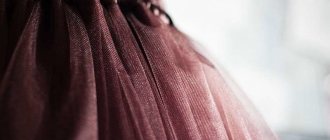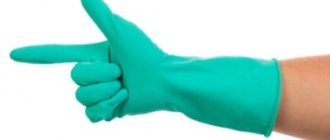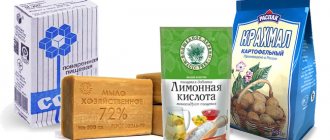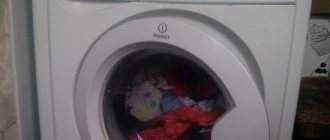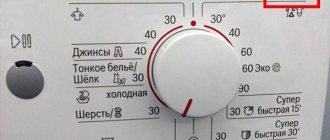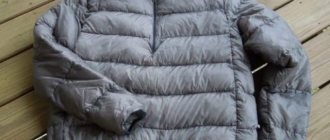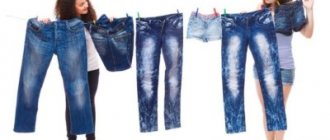Many fashionistas refuse white clothes because of their impracticality - maintaining the snow-white shade of the fabric for a long time is not easy, and any stains immediately catch the eye.
What about white curtains, sheets, tablecloths, and towels? It turns out that every self-respecting housewife should still know how to bleach white things at home.
Not every item can be treated with factory-made bleach, so let's look at other ways to return fabric to its original white color.
How to check shedding tendency?
To avoid the question of what to do to prevent things from being dyed, you need to be able to test clothes for a tendency to shed. After all, it is easier to prevent a problem than to fix it.
If the colored clothes are very bright, this does not mean anything. These clothes may not fade, but it doesn't hurt to check.
Simple ways to determine whether a product is painted or not:
- When washing a new jacket for the first time, soak it in hot water (if it can be exposed to high temperatures) and wring it out.
- Clothes are checked for shedding by soaking. Pour water into a basin and add washing powder, leave for 10 minutes, then squeeze out the water. The water, which has turned a different color, will show whether the dress is fading or not.
- A colored item is treated with a damp white cloth or napkin. If the paint comes off, use a napkin to paint it.
- Look at the inside for a sample of fabric. For high-quality and expensive items, manufacturers do not spare a piece of such material so that they can check whether the product is fading or not. Cut a piece and test it.
- Soak the sample in ammonia for 10 minutes, then compare it to the clothing. If the product is brighter than the tested sample, it means it is fading.
Such a test should be carried out every time you buy a new product in order to know which items can be washed with or placed separately from all clothes.
This is interesting: How to wash tulle so that it is white: salt, peroxide and effective methods
How to prevent staining
Preventing staining of fabrics is easier than removing stains. This is a truism familiar to every housewife. Especially the one who had to urgently bleach stains from her clothes.
Sorting
This is the basic rule. We sort not only by color (white, light, different colors, black), but also by the composition of the material. Natural linen with synthetics cannot be washed.
We wash new items separately
Introduce new clothes to water and powder as carefully as possible and separately from other things: we don’t know how the fabric will behave. The examination can be carried out in a separate small area. Wet the edge of the fabric with warm water and see what happens.
Temperature
Even items washed several times can suddenly fade due to hot water. It's simple: the higher the washing temperature, the easier the paint particles are washed out.
Wash certain items by hand
Inspect the details of the clothing carefully: even stripes, pocket lining or collars may fade, leaving stains on lighter areas. Treat such items in cold water and quickly; do not soak them for a long time.
Note color fixing tricks: vinegar and salt solution for pre-soaking. Special washing conditioners will help restore the brightness and color of dyed clothes.
Tip How to wash a black dress with a white collar: soak the item briefly in soapy water, wash, rinse and wring out. Then lay it out on a flat surface and apply the bleach solution strictly to the collar. After 15-20 minutes, rinse the dress completely again and send to dry.
Don't delay rescuing faded clothes
The most important rule for damaged clothes: start bleaching immediately while they are still wet. Usually stains are noticeable immediately after removing items from the drum. Always inspect your clothes after washing. Any old stain is much more difficult to deal with than a fresh one.
Source of the article: https://gidpotkanyam.ru/belaya-odezhda-okrasilas-pri-stirke.html
Is it possible to wash black and white, what will happen to things when washed together, what to do if clothes are faded and how to bleach them, How to wash a white item if it was washed with black.
What colors are most likely to fade?
Not all fabrics have the ability to shed or lose color.
Most often, fabrics made of brightly colored cotton material are “divided” of excess dye. Denim fabrics usually fade intensively (especially when washed with hot water). Things of the following colors are highly susceptible to shedding:
- red;
- orange;
- green and dark green;
- brown.
In general, almost every saturated shade can cause trouble and transfer its color to other things when washed together.
Interesting! If you wash items from the following color combinations at the same time, you don’t have to worry about unpleasant staining:
- blue, gray black;
- any shades of red and yellow;
- a variety of colorful and rich tones;
- green, brown, purple and blue.
To avoid accidental coloring, you should adhere to the following recommendations:
- carefully sort items before washing;
Be sure to sort your items before washing
- withstand temperatures of 30
OC (modern detergents can wash well at such temperatures, with the exception of bed linen);
- gentle squeezing helps reduce tissue damage and washing out paint from them;
- selection of material of approximately the same density (to avoid the effect of increased friction, leading to intensive washing of paint from the material).
Things to remember
- Choose a detergent based on the type of fabric. Chlorine-containing products are suitable for hand washing adult cotton clothing. Oxygen - for all types of fabrics, including children's and colored ones. Optical - only for white products.
- Do not boil something with a pattern or photo print, it will ruin it.
- Dry white clothes made from natural fabrics outdoors , and synthetic ones indoors.
- When washing, follow the temperature recommended by the manufacturer.
- Do not wash white items in hard water , the material will turn grey.
- Before washing, be sure to sort items by color (white-colored-black) and type of fabric (delicate-thick) so as not to spoil the color and material during washing.
- Wash the product immediately after soiling . Old stains are more difficult to remove.
Emergency recovery
The first thing many housewives do immediately after discovering stains is to put things in the drum again. That's right, try adding more powder or gel, as well as oxygen bleach. An alternative is to rub the wet item with a bar of laundry soap and let it sit for half an hour and then wash it.
Household methods
When things get dyed during washing, household products will come to the rescue. Here are some proven recipes:
- The clothes are soaked in soapy water with the addition of 4 tablespoons of vinegar. The cleansing procedure takes 7-9 hours, so it is wise to soak things overnight.
- When boiling stained laundry, add vinegar to the container at the rate of 1 tablespoon per 2 liters. If the color of the product has changed unevenly, you need to place the clothing for 4-5 hours in a thick solution of soda and warm water. The consistency should be thick.
- Treat the reverse side of the product with lemon juice (substitute: a bag of citric acid per 400 ml of water). The product is effective for 2-4 hours. If things are painted white, you cannot use this method: lemon leaves stains on light-colored materials.
- If a white item has lost its purity of color, the most effective is to use hydrogen peroxide, ammonia and water mixed in a 2:1:1 ratio. Clothes are soaked in this solution for several hours.
The final stages of each item are washing the product by hand or in a machine, rinsing.
How to bleach faded whites
How to bleach faded whites
Caring for white material is much more difficult than caring for plain or variegated ones. To “reanimate” such a thing, you need to make every effort. If white linen is stained during washing, every housewife should know what to do in such situations. The method will depend on the type of material.
Natural fabric
First, you need to wash the damaged item again, then try several “grandmother’s” methods:
- Potassium permanganate. The method is risky, so it should be used if other rescue measures have failed. Take a little substance, add powder and hot water. Soak the laundry in the resulting solution for a couple of hours, rinse in water. It is better not to use this method for “delicate” fabrics.
- Lemon juice. If your white linen has faded, an experienced housewife knows how to bleach it - lemon. The fruit is known for its whitening properties. It is enough to wipe the damaged areas with juice and leave for 3-5 hours. If delicate fabric is damaged, you can dilute the juice with water and soak the fabric in the resulting solution. Next, the item is washed and dried.
- Ammonia. Prepare a basin, pour in 6 liters of water, but not too hot, add 200 milligrams of ammonia. Soak the product for half an hour.
- Digestion. If the linen faded, even the grandmothers knew what to do. The item was immersed in a metal pan or bucket, boiled for a couple of hours, and rinsed in cold water. To improve the result, you can add 2 tablespoons of soda or one ammonia.
- The use of citric acid, starch and table salt. The ingredients are mixed in equal quantities with water to obtain a mushy mixture, applied to the faded area and left for half an hour. You can also add whitening soap shavings.
- Hydrogen peroxide. Take four liters of water, add 50 ml of peroxide, pour the solution into a bucket or pan, place the damaged item and place it on the stove. After waiting for the water to boil, set the heat to low and wait 1 hour.
- Laundry soap. The product is applied to the damaged area, left for 4 hours, but to keep the item damp, wash it by hand or in a machine.
Important! Boiling and potassium permanganate can completely ruin clothes, so resort to similar bleaching methods in desperate situations.
Synthetics
For synthetics, washing at high temperatures, using chlorine, and drying under the scorching sun are harmful. If clothing made from artificial fabrics has deteriorated, there are three ways to correct the situation:
- take hydrogen peroxide (2 tbsp), ammonia (5 tbsp) and laundry soap dissolved in water. The ingredients are mixed, 10 liters of water are added, then you need to leave the item for half an hour, rinse 3-4 times;
- aspirin. It is necessary to dissolve two tablets of the medicine in one hundred milliliters of water and apply the mixture to the affected area;
- laundry soap. Lather the item, leave for 30 minutes, rinse.
It is better not to use the last method on colored items, as you can aggravate the situation by completely ruining the item.
Delicate material
If items made of silk, wool or other delicate fabrics have been dyed, but you don’t know how to bleach faded linen at home, use the following methods:
- Take a tablespoon each of ammonia, powder and peroxide, add another 4 tablespoons of salt and five liters of water. Leave the item in the resulting mixture for a couple of hours, rinse thoroughly.
- Place a spoonful of mustard powder in a liter of boiling water, leave for 3-4 hours and wash damaged clothes or bedding in the solution.
It is not recommended to boil “delicate” fabric or wash it in high temperature water.
This is interesting: How to iron things quickly without an iron at home
How to bleach a faded item
White items require special treatment when washing. Even a slight change in tone ruins your underwear or your favorite shirt. Fortunately, even in your home medicine cabinet you can find something to remove stains or whiten the entire thing.
Hydrogen peroxide
An economical and easy way to freshen up white fabric. To do this, add 3 tablespoons of 15% hydrogen peroxide to a bowl of warm water and leave things in it for an hour. Then they need to be rinsed in running water and dried.
If you wash it in a machine, pour 2 tablespoons of peroxide into the powder compartment. Further cutting is carried out in a mode suitable for the fabric.
Potassium permanganate with laundry soap
The method is suitable for cotton linen, baby diapers and linen clothing.
- You need to soak the item in a soapy solution, rubbing the most contaminated areas thickly with laundry soap.
- Potassium permanganate is added to a glass of water on the tip of a knife to create a dark purple color.
- Water is poured into a basin or bucket and things are placed. You only need a little water to completely cover the clothes.
- A glass of potassium permanganate is poured into the same container.
- After two hours, items should be removed and rinsed in clean water.
Drawings with this method do not fade, and the linen acquires a fresh boiling white color.
Stain remover
Choose a stain remover for each type of fabric, or one labeled “universal.” If it is intended for bleaching, then colored or patterned items cannot be washed in it. Use it for hand or machine washing according to the instructions for best results.
Vinegar
When removing stains from shedding or any other contaminants, vinegar helps 100%. To do this, dampen the stains with a cotton swab and leave for 20 minutes. If you have a large amount of clothes, add 1 cup to the detergent compartment when rinsing in the machine. When washing by hand, add half a glass of water to a basin after washing the item with powder, and leave the item in it for an hour.
Ammonia
Ammonia is suitable for both natural and synthetic fabrics. It is added to the powder in the amount of 2 teaspoons per basin, or half a glass for a washing machine. After ammonia, the white item becomes clean, while the colored elements do not lose color.
Domestos
As a last resort, you can bleach things using Domestos. 1 teaspoon should be diluted in a basin of water, leave things in it for 10-15 minutes and rinse thoroughly. Domestos will whiten colored items and prints or distort the color. It will be impossible or very difficult to fix this. Therefore, the method is suitable exclusively for whitening.
How to identify fabric that can be dyed
To avoid problems, check the item for shedding tendency. You can do this right in the store or at home. There are five effective methods:
- Run a damp cloth over the material and see what happens, whether there is paint.
- Wet a piece of fabric with water and iron it through a light-colored fabric.
- Rinse in hot water, squeeze, evaluate the resulting color of the water.
- Soak the product for a few minutes in water with added powder, then squeeze it onto white paper.
- Some manufacturers attach a sample that makes it clear whether the product sheds or not. Cut a piece, pour ammonia, leave for 6-8 minutes, rinse and dry.
The fabric can be dyed in grey, black, red, blue, green and other variegated colors. Never wash items of these shades together with white fabrics.
How to restore the color of clothes that have faded in the sun?
Rinsing with ordinary table vinegar or baking soda will help to refresh and slightly restore the red and blue colors in clothes. Soda can also be added when washing blue clothes: just one dessert spoon per liter of water helps to return the clothes to their salable condition. The fact is that organic acids in small quantities help strengthen any bright shade and keep products looking fresh for a long time.
Many people advise using ammonia diluted in warm water. Blue and light blue items placed in such a solution will regain their lost brightness in just a couple of hours.
The use of special fabric dyes will help restore the color of clothes faded by the sun. When using such products, it is necessary to strictly follow the attached instructions. Sometimes, in order to return the lost shade to the damaged item, it is enough to wash it with other items of a similar color.
Items made from colored fabrics are usually washed together, so they suffer from shedding more often. Measures to restore their appearance also depend on the type of fabric.
Natural fabrics
The following methods are effective:
- Repeated wash on intensive cycle. Dyed clothing should be washed again at a higher temperature (if allowed on the tag) and with more detergent. So the thing will paint over itself.
- Ammonia. For 10 liters of water take 1 tbsp. l. substances. The item of clothing is soaked for 20 minutes, boiled and rinsed well.
- Washing powder with hydrogen peroxide. 50 g of powder is combined with 15 ml of peroxide and diluted with water. Soak the damaged item in the mixture for an hour and rinse.
Help in cleaning items made from synthetic fabrics will be provided by:
- A mixture of lemon juice, starch and laundry soap. The ingredients are mixed in equal parts and applied to areas of contamination. After a couple of hours, the clothes are washed in the usual way.
- Repeated rinsing in clean water. Effective for fresh stains.
How to restore colored items?
It is much more difficult to return the original shade to colored products. In this case, you should not only preserve the original appearance of the item, but also remove the paint from it. The effective methods listed below will help you do this.
Ammonia
Ammonia (aka ammonia) will help restore fresh color. To do this, you need to use the following recommendations:
- dilute 50 ml. ammonia in 5 liters of warm water;
- place the damaged item in a container;
- after 1.5 hours, the product is removed and rinsed well;
Dry clothes in the fresh air, hanging them in such a way that direct sunlight does not fall on the laundry. Exposure to ultraviolet radiation can change the original color of your favorite blouse or skirt.
Chalk
Regular chalk will help give a fresh look to faded clothes. To do this, you need to grind it and dilute it with warm water. The color of the chalk must completely match the color of the damaged item. For 5 liters of liquid you should take 100–150 g of chalk.
The laundry is soaked in the resulting mixture for about 4–5 hours, after which it is rinsed in water with the addition of a bite (4 tablespoons of essence per 7 liters of liquid). This additive will help the color to take hold in the fabric for a long time.
Dish detergent
Using dish soap to restore the original shade of colored items is only advisable if the stains are not so pronounced. If the stains are very slight, you can use regular 70% laundry soap.
How to use dishwashing detergent? To do this, you need to wet the faded items with warm water, apply the detergent composition to a sponge and blot the stains with it. Leave the products in this form for about 3 hours. After this, things need to be rinsed well. To consolidate the result, it is recommended to wash them in a machine with regular powder.
In addition, you can resort to the help of special stain removers, which are designed to restore colored items to their original shade. As mentioned earlier, they are all labeled Color. The following products are most effective for faded laundry:
- ACE Oxi Magic;
- Vanish color protect;
- Amway PreWash Spray;
- Astonish OXY PLUS;
- Sarma Active 5 in 1.
All of the listed products quickly and effectively return the original color to the laundry.
Original methods for rescuing damaged clothes
If one of the above methods does not help, you can decorate the stain or stains. Thanks to simple steps you will get a unique item with a minimum of effort.
Exclusive ideas:
- If a stain appears on your favorite clothes, increase the number of stains. Watercolor or special paint for the material is suitable. Place cardboard inside, place patterns in random order with a sponge, dry and iron. The resulting item is washed at a temperature of no more than 40 degrees;
- cotton, calico or cotton fabric is boiled in aniline dye. Please note that wool will decrease in size after processing, and acrylic will increase;
- complete the spot with regular felt-tip pens, creating an original print;
- If you have stencils on hand, use watercolors and a sponge to draw a pattern of a suitable size to hide any imperfections.
When you don’t want to use paints, you can embroider any pattern or decorate the damaged area with beads, ribbons or rhinestones.
How to act immediately
There is no need to get too upset and throw away the painted item or turn it into workwear for the garden.
There are several simple and effective methods, the immediate use of which will help restore your previous color.
- Act quickly. Do not let the affected clothing dry, much less iron it. Drying at high temperatures will only set the paint, making subsequent removal more difficult or even impossible.
- Digestion is not suitable for every material. Many fabrics, especially synthetic ones, become deformed during aggressive heat treatment. In this case, it will not be possible to return things to their former attractiveness.
- After an unsuccessful wash, try washing the dyed clothes again, but now exclude all suspicious materials, or better yet, wash them separately. Use an active washing powder and set the temperature to close to 60˚C, but no more than the clothing tag allows.
- If white fabric is damaged, add oxygen-containing bleach to machine wash. Soak in white if the material is able to safely survive such a procedure.
We return faded things to their former purity - video:
How to bleach things with prints and patterns
We've dealt with pure white things. But what if you have a color print on your T-shirt?
If you have a dyed T-shirt with a pattern, you can try to solve the problem using oxygen-containing bleaches, which we talked about above. Oxygen and soda, which are included in such bleaches, will help preserve the item and remove stains.
If you have a strongly colored drawing that “bleeds,” then most likely you are dealing with a low-quality item. The print was made with poor cheap inks. Such things had to be washed in warm, even cool water, so that the design would not crack or blur. You, of course, can apply the product directly to problem areas to bleach a faded item more effectively, or you can also try this option:
- “Do not dry an item if you find that the design on it has faded. I saved the T-shirt for almost a day. As soon as I noticed that the print was running, I quickly soaked the item in bleach powder. Rubbed it well. I let the thing sit there for a while and rubbed it again. And so every hour, or even more often. It helped! So, now I advise everyone.” Julia.
- “When washing, a black stripe found itself on a white one. The T-shirt has faded, to put it simply. I also did laundry for a long time and tediously, almost the whole day. So, for sure, effort and work will grind everything down. You take it and wash the problem area again several times. The method works! Then I even bleached an old faded T-shirt like this.” Zhenya.
We think that you will definitely return the whiteness to your favorite things by using our tips.
In case of failure
What to do if it was not possible to return the damaged item to its original color? The way out would be:
- Masking of defects. If the item is only partially painted, in some places, you can select a suitable applique and stick it over the stains. Another option: creatively play with the spots, making them the center of the composition, and add an abstract ornament or meaningful design on top of them. The problem is that it will not look appropriate and beautiful on all things.
- Work use. The painted item is suitable for the role of a work suit for the dacha or during repairs. After such use, it is not a pity to throw away a wardrobe item.
- Creative uses. Creative individuals can use unsuccessfully washed blouses or dresses to sew toys, pillows, patchwork items, etc.
So, a damaged item can always be given a second life.
How to return the product to its original appearance?
If emergency steps to remove stains from faded clothes do not help, then you should use traditional methods or special household chemicals.
Folk methods on how to save laundry
There are a sufficient number of folk ways to quickly remove stains from clothes that have faded after washing:
- Starch, table salt and citric acid. The ingredients are mixed in equal proportions and poured with warm water until a thick paste forms. The resulting product is used to treat stains. The product is left alone for ten hours, after which it is washed in the usual way.
- Vinegar. Faded clothes are soaked overnight in a soap solution with the addition of 3-4 tbsp. vinegar.
Lemon juice is a great remedy for faded whites. It is enough to wipe the colored stains with half a fresh lemon and leave the item in this form for three to four hours. The clothes are then washed again as usual.- Liquid dishwashing detergent . The steps are simple: rub stains on clothes with detergent until foamy. After two hours, the treated clothes are sent to the washing machine.
- Salt and green tea . The painted item is soaked in brewed green tea of medium strength (for no more than twenty minutes). Then the product is taken out, squeezed out and the faded areas are covered with table salt. The clothes are left in this form for fifteen minutes, after which they are sent for re-washing.
It is necessary to start removing stains from faded clothes using traditional methods as quickly as possible.
Delay in solving the problem may result in the stains not being removed and the item being completely damaged.
How to correct the situation using household chemicals?
Properly selected chemicals will help restore the original color of a faded item. Stain removers and oxygen bleaches will help get rid of stains on faded clothes .
Top 3 best chemicals to combat stains on faded clothes:
Vanish Oxi Action . Bleach is effective at low temperatures (which is important for washing delicate fabrics) and has a pleasant smell. The cost of this product starts from 171 rubles.- BOS Maximum is an oxygen bleach, suitable for both white and colored laundry. BOS Maximum is produced in the form of a dry powder. It is added to the washer compartment along with detergents or used for soaking during hand washing. The cost of bleach starts from 80 rubles.
- Clean Home is a liquid stain remover that can be used in both cold (30°C) and very hot (90°C) water. Clean Home does not contain chlorine, preserves the brightness of colors and the structure of fabric fibers, and enhances the effect of washing powder. The cost of liquid stain remover starts from 260 rubles.
When choosing a product in a store, you must carefully study the manufacturer’s information on the label regarding the method of use and dosage.
It is better to avoid products containing chlorine, as there is a high risk of permanent damage to the dyed item after washing.
To choose the right product, you should adhere to the following recommendations:
- oxygen bleaches will help in removing stains from faded white clothes;
- washing with a stain remover will save colored fabrics from faded stains;
- Laundry soap will do an excellent job with colored stains, but it is better to use it for dark things (yellow soap can leave a dirty residue on white fabric).
Experts do not recommend washing faded clothes more than three times. Frequent washing leads to thinning of fabric fibers, final loss of color and shape of clothing.
The simultaneous use of chemicals with different properties is not recommended. By reacting, such combined compounds can cause final damage to your favorite item (the color changes, the color pigment is washed out of the fabric).
other methods
If household chemicals and traditional methods cannot cope with stains on faded clothes, the following methods will help save your favorite item:
Painting with acrylic paints. Showing imagination or using a stencil, the faded areas on the fabric are painted with acrylic paints. They are easy to apply and dry quickly.- Boiling in aniline dye. As a result, faded clothing acquires a uniform color, masking any defects on the fabric.
- Decorating painted areas with applique, rhinestones, and embroidery.
Faded clothing can become the basis for creating new interior items (for example, pillowcases for sofa cushions).
How to bleach a white jersey T-shirt
Classic, high-quality white T-shirts are made from cotton jersey with minimal addition of synthetic fibers. It is not difficult to bleach a white T-shirt made from natural material, since cotton withstands aggressive influences and retains its structure and shape. You can safely use one of the following three methods.
Before starting whitening, carefully study the composition of the product, which is indicated on the label. Methods for knitwear are suitable if the item consists of 50% or more natural fibers.
Chlorine
Peculiarities. If your shirt has turned grey, the easiest way is to use bleach or another chlorine-based bleach. It is useful to repeat this procedure after several washes. But follow the recommended proportions and time, otherwise chlorine may damage the fibers.
Instructions
- Wash the T-shirt as usual.
- Prepare a solution at the rate of one tablespoon of bleach per 3 liters of hot water.
- Dip the T-shirt in the bleach and soak it thoroughly.
- Leave for 15-20 minutes.
- Rinse thoroughly in cold water.
Boiling
Peculiarities. Removing old yellow stains from a white cotton T-shirt is more difficult. If you want to restore the freshness of your favorite T-shirt, which you are not ready to part with, you will have to revive it by boiling.
Instructions
- Pour water into a large enamel pan or basin and dissolve bleach for natural fabrics in it (see the instructions for the product for the quantity) and a couple of spoons of washing powder (shavings of laundry soap).
- Submerge the shirt in water.
- Place the container on the stove and boil the product for 15 minutes to an hour, depending on the degree of contamination.
- From time to time, turn the T-shirt over with a wooden spatula so that the item is evenly saturated with the solution.
- After boiling, leave the T-shirt to cool in the soapy solution.
- Rinse the item in a large volume of water.
Ammonia
Peculiarities. Experienced housewives know that using ammonia can get rid of various contaminants, so they use the drug to clean the house. An ammonia aqueous solution will also help get rid of stains on a white T-shirt and return it to its whiteness.
Instructions
- Mix three tablespoons of ammonia and 3 liters of warm water (30°C).
- Place the washed T-shirt in the solution for three hours.
- You can speed up whitening by adding a little washing powder.
- Rinse.
- If possible, dry the T-shirt in the sun to ensure the effect lasts.
Features depending on material
When choosing a method for restoring the color of faded clothing, special attention is paid to what material the product is made from.
Natural fabrics
You can wash faded items made from natural fabrics in the following ways:
Digestion method . Painted items are boiled for at least two hours in a bucket or large pan filled with water with the addition of baking soda (2 tbsp is enough for 10 liters). After boiling, the product must be rinsed thoroughly in cool water.- Soaking method . Ammonia is dissolved in warm water (200 ml of ammonia is used for 6 liters). Damaged clothes are soaked for an hour, after which they are thoroughly rinsed under running cool water.
Unlike synthetic materials, faded stains are more difficult to remove from natural fabrics. If it was not possible to return the original color to the product the first time, you will have to repeat the procedure or seek help from dry cleaning specialists.
Synthetic
To restore the color of faded clothing made from synthetic fabrics, the following methods are used:
- Two aspirin tablets are crushed into powder and dissolved in 100 ml of warm water. Treat stains with the resulting composition, leave the product for twenty minutes, then wash as usual.
- Dissolve 5 tbsp in 10 liters of warm water. ammonia, 2 tbsp. hydrogen peroxide and 2 tbsp. laundry soap shavings. Soak faded items in the prepared mixture for half an hour, then rinse thoroughly in cold water.
When washing synthetic fabrics, it is necessary to avoid high temperatures, as well as the use of chlorine-containing products.
Wool, silk, delicate
You can restore the original appearance of faded clothes made from delicate, thin fabrics in the following ways:
Dissolve 1 tbsp in 5 liters of water. washing powder, hydrogen peroxide, ammonia and 4 tbsp. table salt. The painted item is soaked in the resulting solution for two hours. The product is then washed as usual.- Wash the faded item in mustard tincture (brew 1 tablespoon of dry mustard powder in 1 liter of hot water).
- Lemon juice will help quickly remove stains from dyed items after washing. It is enough to squeeze the juice of one lemon into warm water and soak the damaged item in the resulting solution for thirty minutes. After the soaked product is washed as usual.
Delicate fabrics require careful handling. During the washing process, clothes should not be actively rubbed, twisted or soaked in very hot water.
How to wash a white faded item
Often there are white things that have black or colored inserts. For example, a white shirt with a blue collar or a snow-white sundress with black ribbons. Such items should be washed only in cold water. Sometimes unscrupulous manufacturers make these colored inserts from low-quality material that fades. As a result, after washing, black or colored marks from these inserts remain on the snow-white fabric of clothing. How to get rid of them and save your favorite white thing? Let's try to figure it out.
- If there are colored stains on white clothes, try removing them with a white laundry stain remover. To do this, pour a little product onto the stain and leave for half an hour. After this, wash the item in cold water. If the item of clothing has colored inserts, do not soak the entire item in bleach.
- If white clothes have just faded, they need to be soaked in ice water with a glass of table salt. Salty cold water perfectly corrodes paint and brings it out. It is unlikely that it will be possible to remove old stubborn stains this way.
- When there are colored and white items in the pile of washed laundry, you need to re-sort the clothes and leave only white items of clothing. Wash them again on a high temperature with plenty of bleach.
- If stains remain after washing, you can soak the white item in bleach for 6 hours or more. Oxygen-containing bleaches remove stains very well. Do not leave items in chlorine bleach for more than 5 hours. This can damage the structure of the fabric and the item may simply tear very soon.
- You can return things clean and white by boiling them. Dissolve some laundry soap and baking soda in water. Bring the solution to a boil and place white items in it. Boil them over low heat for about two hours. After this, rinse the clothes thoroughly and hang them to dry. Boiling is an effective way to remove stains and colored stains.
- There is another effective folk recipe for resuscitating white clothes. Dissolve a piece of laundry soap the size of a matchbox in water. Add half a glass of salt and a couple of tablespoons of starch, squeeze out the juice of one lemon. Dip things into this solution (the water should be warm). Leave white clothes to soak overnight. And in the morning, wash at 60 degrees in the machine.
- If all methods have been tried, but the stains stubbornly refuse to be removed, the last option left is the most effective and “nuclear”. I advise experienced housewives to bleach things... with hair dye! Choose some blonde shade, like “ash blonde” and dilute it in water. Soak your clothes in this mixture and you are guaranteed crystal whiteness.
How to remove stains and restore white color?
There are several ways to return radiant whiteness to plump clothes:
- Digestion with the addition of hydrogen peroxide . It is enough to dilute hydrogen peroxide (50 ml) in a liter of water and boil the faded white thing in the resulting solution for one hour.
- Treating stains with laundry soap . The faded areas are thoroughly rubbed with soap and the product is left for four hours, after which it is sent for re-washing.
- Treating stains with a mixture of citric acid, starch and salt . The components are mixed in equal proportions, water is added until it becomes a thick paste. The resulting composition is used to treat stains on faded clothing.
- Washing in potassium permanganate . Prepare a very weak solution of potassium permanganate (a few granules per 10 liters of water are enough), in which the dyed item is soaked for twenty minutes. Afterwards, the product is rinsed and washed again as usual.
The method of soaking in potassium permanganate is used as a last resort, since a miscalculation in the number of granules used can completely ruin the faded item.
How to bleach things at home with peroxide?
Hydrogen peroxide is a very affordable medical product and a good bleach.
Thus, removing unnecessary shade from a white item acts sparingly, without aggressively affecting the fabric fibers.
Initially, wash the item simply with powder. This way you can clearly see which stains need to be removed. Persistent stains must be removed. Next, begin the cleansing process:
- Pour hot water into a large basin, the temperature should be 70-80 degrees. This temperature is suitable for rough cotton items.
- For 10 liters of water – 3 tbsp. l peroxide and ammonia solution.
- Soak things for half an hour.
- Wash and rinse them thoroughly. Finish rinsing with cold water.
For more fragile natural fibers, the water should be lukewarm. Then it is better to extend the soaking process to several hours, and enrich the solution with salt and detergent.
Causes
- If clothes or linen were not carefully sorted by fiber composition and color before washing, then even one colored sock that accidentally got into a washing machine with white items can ruin everything. That is, in fact, the clothes became colored when washed against another.
- There are certain colors that are more likely to leach from the fibers of one fabric and be absorbed into another. These are red, orange, blue. But yellow and blue almost never “shed”.
- Not only white things can become stained, but also any light and even bright ones: blue can become dirty purple, pink - gray, etc. Particular attention should be paid to how long you have been using the product: for example, a recently purchased bright T-shirt in During the first two or three washes it will “fade”, but those that have been used for more than one month are unlikely to do so.
- It happens that simple sorting does not help. This applies to multi-colored linen or clothes with decorative elements (embroidery). You need to be especially careful with them.
Traditional bleaches
The easiest way to bleach an item is to use store-bought bleach, but before doing this, carefully study the item's label. There is information about whether the item can be bleached and what kind of bleach is recommended.
Bleach containing chlorine can only be used on cotton and linen items. They are practically not used for machine washing due to the aggressive characteristics of chlorine.
Such bleach will immediately ruin delicate fabrics, but even resistant materials after chlorine bleaching weaken and become more vulnerable to mechanical damage; in other words, they tear easily.
This bleach must be used carefully, in accordance with the instructions on the package; these products are not recommended for asthmatics and allergy sufferers - chlorine has a pungent odor.
Oxygen bleaches are used for washing in a washing machine, as well as for bleaching synthetic fabrics. Such products do not destroy the structure of the fibers.
Oxygen bleaches are safe for health and are suitable even for children's clothing. They not only whiten, but also help remove stains easily.
There are so-called optical brighteners that create an invisible coating on fabric, giving things a snow-white hue.
Folk methods for restoring colored products
Natural fabrics
The following tips will help you get rid of unnecessary color:
- Wash the dyed item in the machine again. But at the same time, set the water temperature to 60 °C and use a larger amount of powder than usual.
- The digestion method will help remove colored stains. First, soak the damaged laundry in a solution of ammonia (1 tbsp per 10 liters of water). After 20 minutes, move the container to the stove, where after the liquid boils, continue cooking for another 10 minutes. Rinse the product in cool water.
Synthetic items
You can put them in order like this:
Take a special anti-stain soap. Rub it. Add the juice of 1 fresh lemon to the soap shavings, as well as 1 tbsp. l. starch. Mix the ingredients well. Apply the resulting paste to the stains. After 2 hours, remove any remaining product, rinse and wash.
Delicate materials
For restoring clothes made from delicate materials
use this recipe:
Soda, 1 tbsp. l., extinguish with 9% vinegar, stir thoroughly. Place this paste on the colored stains and leave to act for 1 hour.
Industrial products for restoring painted products
Manufacturers of household chemicals offer various means for saving accidentally stained items. The effect of their use will be much stronger on newly appeared spots. Old stains are more difficult to remove, since the coloring pigment is firmly embedded in the fibers of the material.
A damaged white item can be washed with bleach. The most common are “Ace”, “Sodasan”, “Bos”. To remove unwanted color, a solvent marked with the “White” icon is suitable. If the type of fabric allows, boil the linen with regular whiteness.
For colored products, we can recommend a product such as Antilin or Korean stain removers Paracle and Oxi Clean.
We use bleach
Such products best restore natural materials; synthetics interact with the active substances of bleaches somewhat more difficult. To whom, in the case of artificial tissues, the desired result may not be achieved. The main rule when choosing bleach is to give preference to products containing oxygen. They are characterized by a soft and at the same time effective action.
For hand washing, it is better to pre-soak clothes in bleach for 6-8 hours. Then wash and rinse. Machine washing requires special care and is only permissible if the tag on the dress or other clothing does not contradict this. Try not to use powder bleaching products in the machine; the gel has a more gentle effect and is no less effective. Before use, dilute the product in a small amount of water, pour it into the conditioner compartment and set it to multiple rinses.
For dense fabrics, local treatment of stained areas can be applied. Apply the cleaning compound liberally to the moistened stain and lightly wash. Then leave it in the aqueous solution for 5-10 minutes and wash it in the usual fabric mode with thorough rinsing.
Measures to prevent staining of clothes
Any things will be clean, retaining their texture and color, if you try to follow simple rules for caring for them:
- It is necessary to sort clothes correctly: first, divide everything into two categories - white and colored items;
- multi-colored ones, in turn, are divided into several groups (for example, pink and red colors will go into one, and blue and black into the other);
Advice. Always wash colored items separately from white items, even if they are already faded.
Useful tips for caring for white items:
- To keep things white longer, wash them separately from colored laundry.
- You need to bleach clothes using any of the methods described above no more often than once every 3-4 washes, otherwise the fabric will quickly become unusable.
- Wash white items right away. Over time, dirt and dust eat into the fabric, and it will be much more difficult to bleach things.
- Wash white cotton and linen items separately from wool and synthetic items, otherwise the clothes will turn gray.
You shouldn’t shy away from white things - if you know how to properly care for them, snow-white blouses, dresses, tablecloths and sheets will delight you for a long time.
Folk methods for restoring white things
Very often, simple improvised means give an amazing result, while they have a less aggressive effect on the material and its structure. The choice of substance and method for removing unwanted color depends on the type of fabric.
Natural fabrics
Use one of the following methods:
- Prepare a basin with 6 liters of warm water, pour in 1 glass of ammonia. Leave faded clothes in the solution for half an hour. Rinse in cool water and machine wash.
- To achieve whiteness, place the painted item in a deep container and fill it with water. Place on the fire and let simmer for at least 1 hour. At the end of the treatment, rinse the clothes in cold water, to which add 2 tbsp. l. soda
- Soak the damaged item in a hydrogen peroxide solution. For 3 liters of water, take 50 ml of peroxide.
- The following substances have a whitening effect: citric acid, salt, starch. Mix the components taken in equal quantities. Pour a little water into the resulting mixture, it should turn out to be a paste. Treat colored stains with this paste. After 30 minutes, carefully remove any remaining cleaning product and wash the product.
- Throw a few granules of potassium permanganate into the water. Be sure to make sure they disappear completely. You should get a weak, light pink solution. Soak the item in it for 20 minutes, then rinse and wash.
Synthetic fabrics
They do not tolerate exposure to high temperatures or chlorine-containing products. To whiten synthetic products, use the following methods:
- Grind two tablets of regular aspirin into powder, add 1/2 cup of water, stir. Treat the stain with the resulting solution and leave to act for 20 minutes. Rinse the item and machine wash it.
- Prepare a bleach solution: take 5 tbsp. l. ammonia, 2 tbsp. l. hydrogen peroxide and 2 tbsp. l. grated laundry soap. Dissolve all components in 10 liters of warm water. Soak the dyed items in this solution, and after 30 minutes, rinse the laundry several times.
Silk, wool, delicate fabrics
The following options are acceptable for whitening them:
- Mix washing powder, hydrogen peroxide and ammonia in a separate container, 1 tbsp each. l. everyone. Add to them 4 tbsp. l. salt. Dissolve the resulting mixture in 5 liters of water. Soak the painted item in the prepared solution. After 2 hours, rinse thoroughly.
- Wash the item in mustard infusion. How to prepare it: 1 tbsp. l. dry mustard powder pour 1 liter of hot water. After 3 hours, the infusion will be ready.
- Squeeze lemon juice into warm water or dissolve citric acid powder in it. Soak items in the solution for half an hour, then wash as usual.
How to whiten a newborn's clothes at home?
The same well-known peroxide . For young mothers, this is a real salvation. Since the product does not contain chemical detergents, this eliminates the possibility of allergic reactions in the child.
- To do this, it is not necessary to pre-soak the item.
- Prepare a solution of peroxide, ammonia and water in the proportions indicated earlier.
- Apply the sponge to the stain and leave for 40 minutes. Then rinse.
An item became colored during washing: useful tips
Read about: how to remove paint from clothes at home.
In addition to the fact that you should never forget about pre-sorting and not washing white with color, there are a few more recommendations, following which you will preserve the original appearance of the products:
- Never wash a new bright item together with other items (even colored ones). This also applies to new jeans - in the first few washes they stain a lot in the water. To ensure that new bright clothes retain their rich colors and do not fade, add a little (2 tablespoons per 5 liters of water) table vinegar to the rinse water. It will fix the dye;
- If you notice that a white item has accidentally become colored during washing, what should you do? First of all, do not dry or iron it. Try washing again immediately before the dye sets in the fibers. Apply bleach if necessary; if the item is stained what to do
- study the information provided by the manufacturer on the clothing label: it always contains fiber composition and care recommendations. Failure to comply with the temperature regime can lead to the fact that even a stable dye will “leave” from the fibers into the water;
- If the product itself is multi-colored, there is also a chance that the lighter areas will become stained. It should be washed by hand in cool water or using special cloths that prevent staining. One such napkin is placed in the drum of the washing machine, and during the cycle it will absorb all the paint that gets into the water from the colored areas, preventing the lighter areas from being painted.
Remember to sort your laundry before washing and always follow the manufacturer's recommendations. Then your favorite things will remain attractive and tidy for a long time. In case of coloring, use one of the special household chemicals (remembering to follow the instructions) or a folk method of restoring color.
Is it possible to wash together, what will happen to the clothes?
Sometimes situations arise in which it is impossible to avoid washing black and white items. Therefore, every housewife should know the secrets that will help prevent black fabric from shedding. Read more about washing black items here.
When is it allowed?
You can wash white and black items together as an exception in the following situations:
- Dark fabrics have been washed many times. The older the item, the less likely it is that the dye contained in its fibers will wash out.
- There will be a quick wash to refresh the fabric.
- There is no need to use aggressive detergents.
- Joint spinning will not take place.
You can wash black and white fabrics at the same time only in a gentle cycle, without soaking.
When is it prohibited?
It is necessary to avoid the combined processing of white and black fabrics in the following cases:
- The black item is new and has never been in contact with water. Even if the item is permanently dyed, it will still fade the first time you wash it.
- Soaking ahead. The longer the product is in water, the more dye will come out of its fibers.
- Requires processing at high temperatures. The hotter the water, the more actively the fabric sheds.
- Black fabric stains heavily. This is not difficult to understand. It is enough to moisten it, wrap it in a light cloth, rub it and leave for 5 minutes. If dark marks appear on the fabric, do not wash it together.
